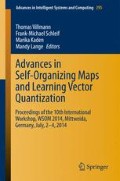Abstract
We introduce a generalization of Multivariate Robust Soft Learning Vector Quantization. The approach is a probabilistic classifier and can deal with vectorial class labelings for the training data and the prototypes. It employs t-norms, known from fuzzy learning and fuzzy set theory, in the class label assignments, leading to a more flexible model with respect to domain requirements. We present experiments to demonstrate the extended algorithm in practice.
Access this chapter
Tax calculation will be finalised at checkout
Purchases are for personal use only
Preview
Unable to display preview. Download preview PDF.
References
Schneider, P., Geweniger, T., Schleif, F.M., Biehl, M., Villmann, T.: Multivariate class labeling in Robust Soft LVQ. In: Verleysen, M. (ed.) 19th European Symposium on Artificial Neural Networks (ESANN 2011), pp. 17–22. d-side publishing (2011)
Bhattacharya, S., Bhatnagar, V.: Fuzzy data mining: A literature survey and classification framework. International Journal of Networking and Virtual Organisations 11(3-4), 382–408 (2012)
Bonilla, E.V., Robles-Kelly, A.: Discriminative probabilistic prototype learning. In: ICML. icml.cc / Omnipress (2012)
Geweniger, T., Villmann, T.: Extending FSNPC to handle data points with fuzzy class assignments. In: Verleysen, M. (ed.) Proc. of European Symposium on Artificial Neural Networks (ESANN 2010), Brussels, Belgium. d-side publications (2010)
Schleif, F.-M., Villmann, T., Hammer, B., Schneider, P.: Efficient kernelized prototype based classification. Int. J. Neural Syst. 21(6), 443–457 (2011)
Schneider, P., Biehl, M., Hammer, B.: Distance learning in discriminative vector quantization. Neural Computation 21(10), 2942–2969 (2009)
Hammer, B., Schleif, F.-M., Zhu, X.: Relational extensions of learning vector quantization. In: Lu, B.-L., Zhang, L., Kwok, J. (eds.) ICONIP 2011, Part II. LNCS, vol. 7063, pp. 481–489. Springer, Heidelberg (2011)
Seo, S., Obermayer, K.: Soft learning vector quantization. Neural Computation 15, 1589–1604 (2003)
Schneider, P.: Advanced methods for prototype-based classification. PhD thesis, Rijksuniveriteit Groningen (2010)
Menger, K.: Statistical metrics. Proceedings of the National Academy of Sciences 28(12), 535–537 (1942)
Gosztolya, G., Dombi, J., Kocsor, A.: Applying the generalized dombi operator family to the speech recognition task. CIT 17(3), 285–293 (2009)
Senthil Kumar, A.V.: Diagnosis of heart disease using fuzzy resolution mechanism. Journal of Artificial Intelligence 5(1), 47–55 (2012)
Ciaramella, A., Tagliaferri, R., Pedrycz, W., di Nola, A.: Fuzzy relational neural network. Int. J. Approx. Reasoning 41(2), 146–163 (2006)
Quost, B., Masson, M.-H., Denaux, T.: Classifier fusion in the dempster-shafer framework using optimized t-norm based combination rules. International Journal of Approximate Reasoning 52(3), 353–374 (2011)
Farahbod, F., Eftekhari, M.: Comparison of different t-norm operators in classification problems. International Journal of Fuzzy Logic Systems 2(3), 33–39 (2012)
Lange, M., Villmann, T.: Derivatives of l p-norms and their approximations. Machine Learning Reports 04/2013, pp. 43–59 (2013)
Schneider, P., Biehl, M., Hammer, B.: Hyperparameter learning in probabilistic prototype-based models. Neurocomputing 73(7-9), 1117–1124 (2010)
Author information
Authors and Affiliations
Editor information
Editors and Affiliations
Rights and permissions
Copyright information
© 2014 Springer International Publishing Switzerland
About this paper
Cite this paper
Geweniger, T., Schleif, FM., Villmann, T. (2014). Probabilistic Prototype Classification Using t-norms. In: Villmann, T., Schleif, FM., Kaden, M., Lange, M. (eds) Advances in Self-Organizing Maps and Learning Vector Quantization. Advances in Intelligent Systems and Computing, vol 295. Springer, Cham. https://doi.org/10.1007/978-3-319-07695-9_9
Download citation
DOI: https://doi.org/10.1007/978-3-319-07695-9_9
Publisher Name: Springer, Cham
Print ISBN: 978-3-319-07694-2
Online ISBN: 978-3-319-07695-9
eBook Packages: EngineeringEngineering (R0)

